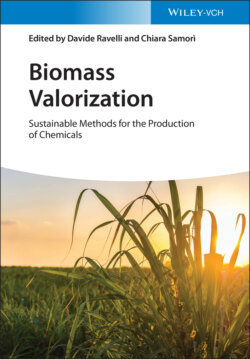Читать книгу Biomass Valorization - Группа авторов - Страница 14
1.3 Lignocellulosic Biomass
ОглавлениеOf all types of biomass, lignocelluloses are the most available on the planet, ranging from wood and forestry waste to straw and agricultural waste. Lignocellulosic biomass is composed of cellulose (40–50%), hemicellulose (15–20%), lignin (25–35%), and other elements (Figure 1.1). Both cellulose and hemicellulose are carbohydrate‐based polymers, while lignin is an aromatic polymer. Cellulose is a linear, glucose‐based polymer, making it a good source of this C6‐sugar. Cellulose cross‐links with hemicellulose, a branched polymer composed of different C5‐carbohydrates, uronic acids, and C6‐sugars. Lignin, perhaps the most irregular component of lignocellulose, is a polyaromatic macromolecule composed of phenylpropane derivatives. Lignin is mostly responsible for structural rigidity within the lignocellulose. Further, lignocellulosic bio‐feedstocks include variable quantities of pigments; terpenes; inorganic elements such as Mn, K, P, Cl, Ca, Mg, and Na, as well as Al, C, Fe, N, S, Si, and Ti to a smaller extent; and various extractives, e.g. carbohydrates, proteins, lipids, waxes, chlorophyll, terpenes, tannins, and uronic acids.
Figure 1.1 Schematic representation of the components of lignocelluloses.
An extensive and systematic review on the composition of various types of biomass shows the significant changes in the composition of these elements depending on the type of biomass [41].
Overall, lignocelluloses are made of highly oxygenated C5‐ and C6‐derivatives. The oxygen functionalities make lignocelluloses a much different feedstock to petroleum sources that are mainly hydrocarbons. The oxygen functionalities in lignocelluloses are in some cases advantageous because they can minimize oxidation reactions, which usually have a negative environmental impact, and favor reduction reactions, which are typically milder processes and have less environmental impact. Further, the propensity to produce coke/humins and ash obliges the use of mild temperatures for these by‐products' minimization, as opposed to the traditional catalytic cracking/reforming of fossils. In fact, the presence of plenty of oxygen functionalities and low volatility tend to lead to the molecules' decomposition at high temperatures, generating carbonaceous residues.
Lignocelluloses have variable composition in their singular components depending on the plant origin. Water and inorganic residue contents also vary significantly from grass to wood. Although composition does vary significantly, biomass can source several useful compounds, including carbohydrates, aromatics, terpene, and fatty esters. These different components can be isolated and converted for use in many applications including pharmaceutical, cosmetics/perfumes, plastics, textiles, and specialty chemicals. For this, several different biomass valorization routes can be envisioned with a wide range of obtainable products.
